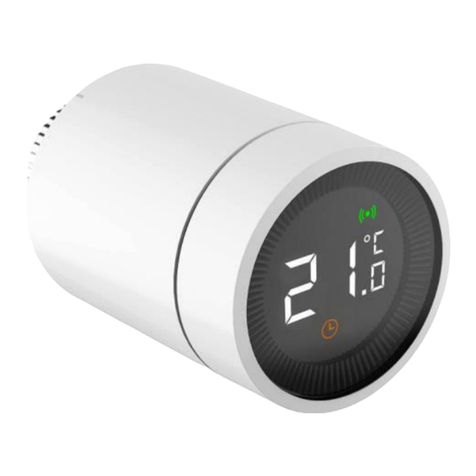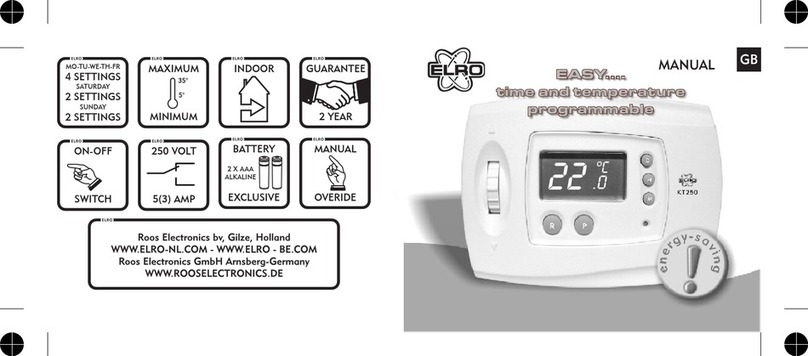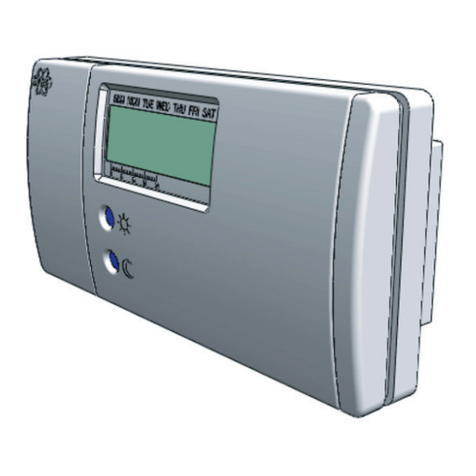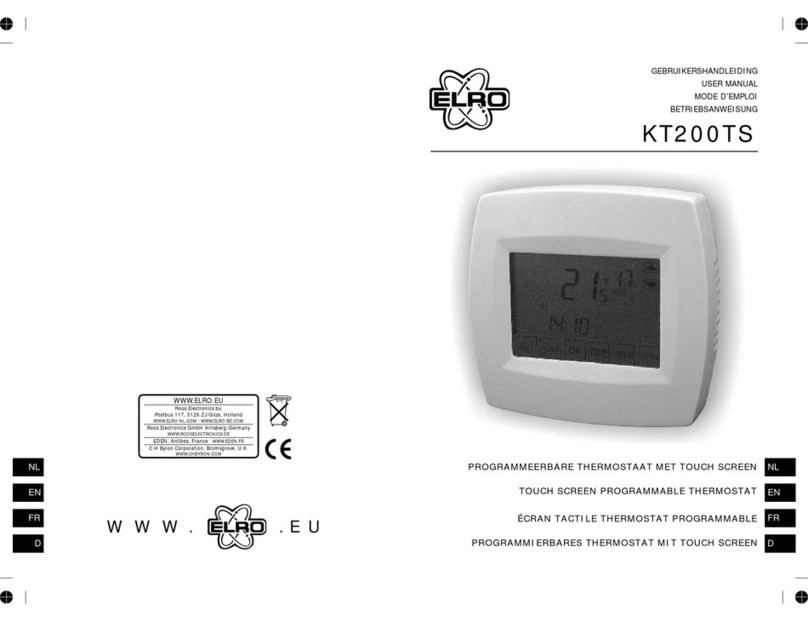5. TEMPERATURE SPAN SELECTION
Span is the temperature difference between the turn on
temperature and turn off temperature. For example, in heating
systems, if you set temperature to 20°C and span to 1°C, the
heater will operate when the room temperature drops to 19.5°C
and turns off when the temperature rises to 20.5°C. Set the DIP
switch (position 1 & 2) according to your selection of temperature
span as the following diagram.
6. BATTERY INSTALLATION
Your thermostat uses two (2) "AA" size alkaline batteries to operate. To power-up the
unit, insert two "AA" batteries into the battery compartment of the front housing. When
power is applied for the first time, the display must show time and the day as well as the
room temperature (for example 28.5°C). If the display is different, press the RESET
button. Use a fine probe such as straightened paper clip to gently push the RESET button.
After installation of the batteries, push back the rear housing to the control centre and
then the stand. Before turning on the main switch of the system, press the reset button
once. The thermostat is ready for use.
7. SETTING CLOCK
1.Press the SET TIME button to clear all digits except the day indicator and the time
display. The day indicator is flashing.
2.While day indicator is flashing, press UP or DOWN button to adjust.
3.Press the SET TIME button again, hour digits are flashing instead of day indicator. Press
UP or DOWN button to adjust. Press and hold the UP or DOWN button to speed up the
adjustment rate.
4.Press the SET TIME button again, minute digits are flashing instead of hour digit. Press
UP or DOWN button to adjust. Press and hold the UP or DOWN button to speed up the
adjustment rate.
5.Press the SET TIME button again to return to normal operation mode.
6.The unit will return to normal operation mode if no key is pressed for 10 seconds.
8. SETTING CONTROL TEMPERATURE
1.Press the SET TEMPERATURE button to display the pre-defined set temperature.
2.Press the CONF/ECON button to toggle between the setting of economic mode and
comfortable mode.
3.Press the UP or DOWN button to increase/decrease the set temperature by 0.5°C.
4.Press the SET TEMPERATURE button again to save the set temperature.
5.The unit will return to normal operation mode if no button is pressed for 10 seconds.
6.The default setting of comfortable mode is 21°C for heater mode and 23°C for cooler
mode. And the economic mode is 18°C for heater mode and 26°C for cooler mode.
9. SETTING PROGRAMS * SELECT WEEK-DAY
1.Press the SET PROGRAM button, the day indicator shows the program day and is
flashing. Program number indicator shows the current program for the selected day.
2.Press the UP or DOWN button to select the day needed to program. You can select the
whole week, working day, weekend,or individual day to program.
1 2 Span
ON ON 1°C
OFF ON 2°C
ON OFF 3°C
OFF OFF 4°C
10. SELECT CONTROL PROFILE * PRE-DEFINED
1.Press the SET PROGRAM button indicator stop flashing and the program starts flash.
2.Press the UP or DOWN
button to select the program
profile. P1-P6 are predefined
program, their profile are
shown as follows.
3.If any of these programs is
selected, press the SET
PROGRAM button again to
confirm this program for the
specified day and return to
normal operation mode.
PROGRAMMABLE CONTROL
PROFILE
4.If temperature setting does
not have to be chagend for a
specific hour, pres to go
to the next hour.
Press the button to toggle the control temperature setting and advance the
settinghour digit by one.
EXAMPLE:
button is pressed. Hour Digit (Clock) is 2 and the 02 hour bar is flashing is on
and the operation mode for hour 01 is set to economic mode.
5.Press the button to terminate the setting procedure and to return to normal
operation mode.
EXAMPLE:
button is pressed.Terminate the setting procedure and the new control profile is :
6.The setting procedure will terminate automatically when no button is pressed for 10
seconds.
11. TESTING THE RF TRANSMISSION RANGE
1.Press UP button until the setpoint temperature is higher than room temperature by a
few degrees.
2.Wait for a few seconds.
3.Check the green LED. It should be On.
4.If the LED is not On, try to place the Control Centre closer to the Receiver. Press Down
button to adjust the setpoint temperature to be lower than room temperature to "turn
off" the receiver.
5.Repeat steps 1 to 3.
6.The receiving range between Control Centre and Receiver is 50M in open area. When
placed indoors, this distance may be shorter because of blocking by concrete walls etc,
but is enough for most household applications.
7.Press RESET button after receiving range testing.
00 06 12 18 24
00 06 12 18 24
00 06 12 18 24
00 06 12 18 24
00 06 12 18 24
00 06 12 18 24
Program 1:
Factory Preset
"Whole day Comfort"
Program number Program profile
Program 2:
Factory Preset
"Whole day Econ"
Program 4:
Factory Preset
"Whole day (A)"
Program 5:
Factory Preset
"Whole day (B)"
Program 6:
Factory Preset
"Half-day work"
Program 3:
Factory Preset
"Holiday"
P
P
00 06 12 18 24
00 06 12 18 24
P
P
-5- -6-

























